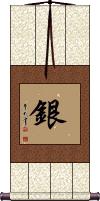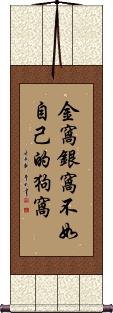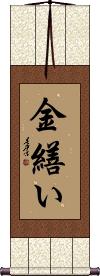Many custom options...
And formats...

Silver in Chinese / Japanese...
Buy a Silver calligraphy wall scroll here!
Personalize your custom “Silver” project by clicking the button next to your favorite “Silver” title below...
Silver
銀 is the Chinese, Japanese Kanji, and old Korean Hanja for silver.
This same word can refer to things that are silver-colored, money or currency, silver coins, or silver paint.
In Japanese, this can be a given name “Ginji.”
There’s No Place Like Home
金窝银窝不如自己的狗窝 is a Chinese slang proverb that means “Golden house, [or a] silver house, not as good as my own dog house.”
It's basically saying that even a house made of gold or silver is not as good as my own home (which may only be suitable for a dog but at least it's mine).
Kintsukuroi
Ten Commandments
十戒 means Ten Commandments or Ten Precepts.
In the Buddhist context, these are prohibitions consisting of five commandments for the layman:
1. Not to destroy life 不殺生 Pāṇātipātāveramaṇi.
2. Not to steal 不倫盜 Adinnādānāver.
3. Not to commit adultery 不婬慾 Abrahmacaryaver.
4. Not to lie 不妄語 Musāvādāver.
5. Not to take intoxicating liquor 不飮酒 Suramereyya-Majjapamādaṭṭhānāver.
The ten commandments for the monk are the preceding five plus:
6. Not to eat food outside of regulated hours 不非時食 Vikāla-Bhojanāver.
7. Not to use garlands or perfumes 不著華鬘好香塗身 Mālā- Gandha-Vilepana-Dhāraṇa-Maṇḍana-Vibhūṣanaṭṭhānā.
8. Not to sleep on high or broad beds (chastity) 不坐高廣大牀 Uccāsayanā-Mahāsayanā.
9. Not to take part in singing, dancing, musical or theatrical performances 不歌舞倡伎不往觀聽 Nacca-Gīta-Vādita-Visūkadassanāver.
10. To refrain from acquiring uncoined or coined gold, or silver, or jewels 不得捉錢金銀寶物 Jātarūpa-Rajata-Paṭīggahaṇāver.
These original Buddhist commandments date back to about 2500 years ago. The English definitions above are followed by Chinese characters and original Pali pronunciation.
Under the Māhayāna Buddhism, these ten commands for the monk were changed, to accord with the new environment of the monk, to the following: not to kill, not to steal, to avoid all unchastity, not to lie, not to slander, not to insult, not to chatter, not to covet, not to give way to anger, to harbor no skepticism.
This in-stock artwork might be what you are looking for, and ships right away...
Not the results for silver that you were looking for?
Below are some entries from our dictionary that may match your silver search...
| Characters If shown, 2nd row is Simp. Chinese |
Pronunciation Romanization |
Simple Dictionary Definition |
洋 see styles |
yáng yang2 yang youji / yoji ようじ |
More info & calligraphy: Ocean(1) Occident and Orient (esp. the Occident); (2) ocean; sea; (prefix) (3) foreign; Western; European; (personal name) Yōji |
銀 银 see styles |
yín yin2 yin ginji ぎんじ |
More info & calligraphy: Silver(1) silver (Ag); (noun - becomes adjective with の) (2) (See 銀色) silver (color); (3) silver (medal, prize, etc.); (4) (hist) silver coin; (5) (abbreviation) {shogi} (See 銀将) silver general; (suffix) (6) (abbreviation) (See 銀行) bank; (7) (archaism) money; (personal name) Ginji rūpya. Silver; money. |
十戒 see styles |
shí jiè shi2 jie4 shih chieh jukkai じゅっかい |
More info & calligraphy: Ten Commandments(1) (Buddhist term) the 10 precepts; (2) Ten Commandments; Decalogue; Decalog; (surname) Jukkai Śikṣāpada. The ten prohibitions (in Pāli form) consist of five commandments for the layman: (1) not to destroy life 不殺生 pāṇātipātāveramaṇi; (2) not to steal 不倫盜 adinnādānāver; (3) not to commit adultery 不婬慾 abrahmacaryaver.; (4) not to lie 不妄語musāvādāver.; (5) not to take intoxicating liquor 不飮酒 suramereyya-majjapamādaṭṭhānāver. Eight special commandments for laymen consist of the preceding five plus: (6) not to eat food out of regulated hours 不非時食 vikāla-bhojanāver.; (7) not to use garlands or perfumes 不著華鬘好香塗身 mālā- gandha-vilepana-dhāraṇa-maṇḍana-vibhūṣanaṭṭhānā; (8) not to sleep on high or broad beds (chastity) 不坐高廣大牀 uccāsayanā-mahāsayanā. The ten commandments for the monk are the preceding eight plus: (9) not to take part in singing, dancing, musical or theatrical performances, not to see or listen to such 不歌舞倡伎不往觀聽 nacca-gīta-vādita-visūkadassanāver.; (10) to refrain from acquiring uncoined or coined gold, or silver, or jewels 不得捉錢金銀寶物 jātarūpa-rajata-paṭīggahaṇāver. Under the Māhayāna these ten commands for the monk were changed, to accord with the new environment of the monk, to the following: not to kill, not to steal, to avoid all unchastity, not to lie, not to slander, not to insult, not to chatter, not to covet, not to give way to anger, to harbour no scepticism. |
大洋 see styles |
dà yáng da4 yang2 ta yang motohiro もとひろ |
More info & calligraphy: Great Sea(noun - becomes adjective with の) ocean; (personal name) Motohiro |
金繕い see styles |
kintsukuroi; kinzukuroi きんつくろい; きんづくろい |
More info & calligraphy: Kintsukuroi |
両 see styles |
liǎng liang3 liang ryou / ryo りょう |
Japanese variant of 兩|两[liang3] (pref,adj-no) (1) both (hands, parents, sides, etc.); (counter) (2) (See 輛・りょう) counter for carriages (e.g. in a train); counter for vehicles; (3) (See 匁・もんめ・1) ryō; tael; traditional unit of weight (for gold, silver and drugs), 4-5 monme, 15-19 g; (4) ryō; pre-Meiji unit of currency, orig. the value of one ryō of gold; (5) (See 反・たん・1) ryō; traditional measure of fabric, 2 tan; (6) (archaism) (See 斤・1) ryō; tael; unit of weight under the ritsuryō system, 1-16 kin, 42-43 g; (counter) (7) (archaism) (See 領・りょう・2) counter for suits of clothing, sets of armor, etc.; (place-name) Ryō |
戒 see styles |
jiè jie4 chieh kai; ingoto(ok) かい; いんごと(ok) |
to guard against; to exhort; to admonish or warn; to give up or stop doing something; Buddhist monastic discipline; ring (for a finger) (1) (かい only) {Buddh} admonition; commandment; (2) sila (precept) śīla, 尸羅. Precept, command, prohibition, discipline, rule; morality. It is applied to the five, eight, ten, 250, and other commandments. The five are: (1) not to kill; (2 ) not to steal; (3) not to commit adultery; (4) not to speak falsely; (5) not to drink wine. These are the commands for lay disciples; those who observe them will be reborn in the human realm. The Sarvāstivādins did not sanction the observance of a limited selection from them as did the 成實宗 Satyasiddhi school. Each of the five precepts has five guardian spirits, in all twenty-five, 五戒二十五神. The eight for lay disciples are the above five together with Nos. 7, 8, and 9 of the following; the ten commands for the ordained, monks and nuns, are the above five with the following: (6) not to use adornments of flowers, nor perfumes; (7) not to perform as an actor, juggler, acrobat, or go to watch and hear them; (8) not to sit on elevated, broad, and large divans (or beds); (9) not to eat except in regulation hours; (10) not to possess money, gold or silver, or precious things. The 具足戒full commands for a monk number 250, those for a nun are 348, commonly called 500. Śīla is also the first of the 五分法身, i.e. a condition above all moral error. The Sutra of Brahma's Net has the following after the first five: (6) not to speak of the sins of those in orders; (7) not to vaunt self and depreciate others; (8) not to be avaricious; (9) not to be angry; (10) not to slander the triratna. |
鈿 钿 see styles |
tián tian2 t`ien tien den |
(dialect) coin; money gold and silver ornamentation |
錠 锭 see styles |
dìng ding4 ting tei / te てい |
(weaving) spindle; ingot; pressed cake of medicine etc; classifier for: gold and silver ingots, ink sticks (1) lock; padlock; (n,n-suf,ctr) (2) tablet; lozenge; pill; (female given name) Tei burning brightly |
錯 错 see styles |
cuò cuo4 ts`o tso saku こすり |
mistake; wrong; bad; interlocking; complex; to grind; to polish; to alternate; to stagger; to miss; to let slip; to evade; to inlay with gold or silver rubbing; scrubbing; scraping to mix |
鍍 镀 see styles |
dù du4 tu |
to plate (with gold, silver etc); (prefix) -plated |
鮒 鲋 see styles |
fù fu4 fu funa ふな |
silver carp (kana only) crucian carp (Carassius spp.); (surname) Funa |
鷴 鹇 see styles |
xián xian2 hsien |
silver pheasant (Phasianus nycthemerus); silver pheasant badge worn by civil officials of the 5th grade |
ラメ see styles |
rame ラメ |
lamé (cloth made from gold or silver thread) (fre:); (personal name) Lame |
丁銀 see styles |
chougin / chogin ちょうぎん |
Edo period silver coin shaped like a sea cucumber; (surname) Chōgin |
七宝 see styles |
nanahou / nanaho ななほう |
(1) {Buddh} the seven treasures (gold, silver, pearls, agate, crystal, coral, lapis lazuli); (2) (abbreviation) (See 七宝焼き) cloisonne ware; (3) (しっぽう only) (abbreviation) (See 七宝つなぎ) shippō pattern (of overlapping circles); (4) (しっぽう only) shippō emblem; (surname) Nanahou |
七寶 七宝 see styles |
qī bǎo qi1 bao3 ch`i pao chi pao shichihō |
sapta ratna 薩不荅羅的捺 The seven treasures, or precious things, of which there are varying descriptions, e.g. 金 suvarna, gold; 銀rūpya, silver; 鐂璃 vaiḍūrya, lapis lazuli; 玻瓈sphaṭika, crystal; 硨磲 musāragalva, agate; 赤珠 rohita-mukta, rubies or red pearls; 瑪瑙 aśmagarbha, cornelian. Also the seven royal (cakravartin) treasures―the golden wheel; elephants; dark swift horses; the divine pearl, or beautiful pearls; able ministers of the Treasury; jewels of women; and loyal generals. |
七珍 see styles |
qī zhēn qi1 zhen1 ch`i chen chi chen shicchin; shichichin しっちん; しちちん |
(1) {Buddh} (See 七宝・1) the seven treasures (gold, silver, pearls, agate, crystal, coral, lapis lazuli); (2) the seven delicacies idem 七寶. |
三金 see styles |
sān jīn san1 jin1 san chin mikane みかね |
(surname) Mikane The three metals, gold, silver, copper. The esoterics have (a) earth, water, fire, representing the 身密 mystic body; (b) space and wind, the 語密 mystic mouth or speech; (c) 識 cognition, the 意密 mystic mind. |
五寶 五宝 see styles |
wǔ bǎo wu3 bao3 wu pao gohou / goho ごほう |
(personal name) Gohou The five precious things, syn. all the precious things. There are several groups, e. g. — gold, silver, pearls, cowries, and rubies; or, coral, crystal, gold, silver, and cowries; or, gold, silver, pearls, coral, and amber; etc. |
五金 see styles |
wǔ jīn wu3 jin1 wu chin |
metal hardware (nuts and bolts); the five metals: gold, silver, copper, iron, tin 金銀銅鐵錫|金银铜铁锡[jin1 yin2 tong2 tie3 xi1] |
元寶 元宝 see styles |
yuán bǎo yuan2 bao3 yüan pao |
a silver or gold ingot; mock ingot (burnt as offering in worship); a name for ancient currency; a rare genius |
光物 see styles |
hikarimono ひかりもの |
(1) luminous body like a shooting star; (2) any bright metal; (3) sliced fish with the silver skin left on (iwashi, aji, sayori, sanma, kohada, etc.) |
六輪 六轮 see styles |
liù lún liu4 lun2 liu lun rokuwa ろくわ |
(place-name) Rokuwa The six kinds of cakravartī, or wheel-kings, each allotted to one of the 六位; the iron-wheel king to the 十信位, copper 十住, silver 十行, gold 十廻向, crystal 十地, and pearl 等覺. |
劫波 see styles |
jié bō jie2 bo1 chieh po kōhi |
kalpa (loanword) (Hinduism) kalpa; also劫簸; 劫跛; v. 劫. Aeon, age. The period of time between the creation and recreation ofa world or universe; also the kalpas offormation, existence, destruction, and non-existence, which four as acomplete period are called mahākalpa 大劫. Eachgreat kalpa is subdivided into four asaṇkhyeya-kalpas (阿僧企耶 i.e. numberless,incalculable): (1) kalpa of destructionsaṃvarta; (2)kalpaof utter annihilation, or empty kalpa 増滅劫; 空劫 saṃvarta-siddha; (3) kalpa of formation 成劫 vivarta; (4) kalpa ofexistence 住劫 vivartasiddha; or they may betaken in the order 成住壤空. Each of the four kalpas is subdivided into twenty antara-kalpas, 小劫 or small kalpas, so that a mahākalpaconsists of eighty small kalpas. Each smallkalpa is divided into a period of 増 increaseand 減 decrease; the increase period is ruled over by the four cakravartīs in succession, i.e. the four ages of iron,copper, silver, gold, during which the length of human life increases by oneyear every century to 84,000 years, and the length of the human body to8,400 feet. Then comes the kalpa of decreasedivided into periods of the three woes, pestilence, war, famine, duringwhich the length of human life is gradually reduced to ten years and thehuman body to 1 foot in height. There are other distinctions of the kalpas. A small kalpa isrepresented as 16,800,000 years, a kalpa as336,000,000 years, and a mahākalpa as1,334,000,000 years. There are many ways of illustrating the length of akalpa, e.g. pass a soft cloth over a solid rock40 li in size once in a hundred years, whenfinally the rock has been thus worn away a kalpa will not yet have passed; or a city of 40 li, filled with mustard seeds, one being removed everycentury till all have gone, a kalpa will notyet have passed. Cf. 成劫. |
取銀 取银 see styles |
qǔ yín qu3 yin2 ch`ü yin chü yin |
to take silver; to come second in a competition |
四輪 四轮 see styles |
sì lún si4 lun2 ssu lun yonrin よんりん |
(can be adjective with の) four-wheeled The four wheels or circles: (1) 大地四輪 the four on which the earth rests, wind (or air), water, metal, and space. (2) Four images with wheels, yellow associated with metal or gold, white with water, red with fire, and black with wind. (3) The four dhyāni-buddhas, 金剛輪 Akṣobhya; 寳輪 Ratnasaṃbhava; 法輪 Amitābha; 羯磨輪 Amoghasiddhi. (4) Also the four metals, gold, silver, copper, iron, of the cakravartin kings. |
多羅 多罗 see styles |
duō luó duo1 luo2 to lo tara たら |
(1) (abbreviation) (See 多羅樹) palmyra; (2) (abbreviation) (See 多羅葉) lusterleaf holly; (3) patra (silver incense dish placed in front of a Buddhist statue); (surname, female given name) Tara tārā, in the sense of starry, or scintillation; Tāla, for the fan-palm; Tara, from 'to pass over', a ferry, etc. Tārā, starry, piercing, the eye, the pupil; the last two are both Sanskrit and Chinese definitions; it is a term applied to certain female deities and has been adopted especially by Tibetan Buddhism for certain devīs of the Tantric school. The origin of the term is also ascribed to tar meaning 'to cross', i. e. she who aids to cross the sea of mortality. Getty, 19-27. The Chinese derivation is the eye; the tara devīs; either as śakti or independent, are little known outside Lamaism. Tāla is the palmyra, or fan-palm, whose leaves are used for writing and known as 具多 Pei-to, pattra. The tree is described as 70 or 80 feet high, with fruit like yellow rice-seeds; the borassus eabelliformis; a measure of 70 feet. Taras, from to cross over, also means a ferry, and a bank, or the other shore. Also 呾囉. |
大頭 大头 see styles |
dà tóu da4 tou2 ta t`ou ta tou daitou / daito だいとう |
big head; mask in the shape of a big head; the larger end of something; the main part; the lion's share; dupe; sucker; (old) silver coin with a bust of Yuan Shikai 袁世凱|袁世凯[Yuan2 Shi4 kai3] on the obverse side (See 幸若舞) school of kowakamai dance founded by Yamamoto Sirozaemon; (surname) Daitou |
宛転 see styles |
enten えんてん |
(adj-t,adv-to) (1) eloquent; fluent; smooth-spoken; sonorous; facile; silver-tongued; (adj-t,adv-to) (2) (of eyebrows) shapely |
Click here for more silver results from our dictionary
The following table may be helpful for those studying Chinese or Japanese...
| Title | Characters | Romaji (Romanized Japanese) | Various forms of Romanized Chinese | |
| Silver | 銀 银 | shirogane / shirogane | yín / yin2 / yin | |
| There’s No Place Like Home | 金窩銀窩不如自己的狗窩 金窝银窝不如自己的狗窝 | jīn wō yín wō bù rú zì jǐ de gǒu wō jin1 wo1 yin2 wo1 bu4 ru2 zi4 ji3 de5 gou3 wo1 jin wo yin wo bu ru zi ji de gou wo | chin wo yin wo pu ju tzu chi te kou wo | |
| Kintsukuroi | 金繕い | kintsukuroi | ||
| Ten Commandments | 十戒 | jukkai / jukai | shí jiè / shi2 jie4 / shi jie / shijie | shih chieh / shihchieh |
| In some entries above you will see that characters have different versions above and below a line. In these cases, the characters above the line are Traditional Chinese, while the ones below are Simplified Chinese. | ||||
Successful Chinese Character and Japanese Kanji calligraphy searches within the last few hours...








